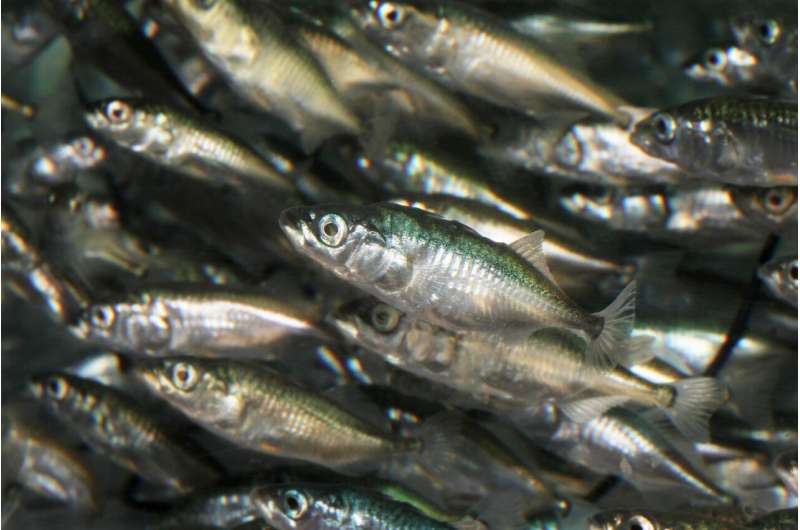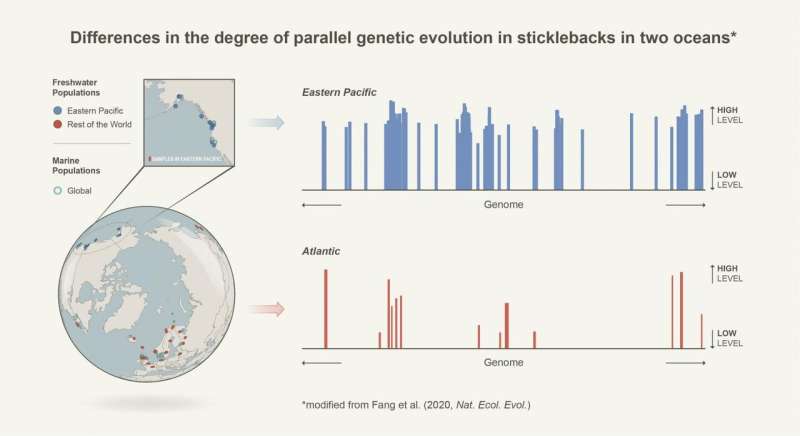Parallel evolution in three-spined sticklebacks

A group of researchers from the University of Helsinki used novel and powerful methods to disentangle the patterns of parallel evolution of freshwater three-spined sticklebacks at different geographic scales across their distribution range. The group concludes that the conditions under which striking genome-wide patterns of genetic parallelism can occur may in fact be far from common—perhaps even exceptional.
The three-spined stickleback (Gasterosteus aculeatus), a thumb-sized fish distributed across the Northern hemisphere, is a textbook model species in evolutionary biology. With the retreat of ice sheets since the last glacial maximum, ancestral marine populations have repeatedly colonized newly formed freshwater habitats. Across their distribution range, sticklebacks in these novel freshwater environments exhibit remarkable similarities in their morphology, physiology and behavior, a phenomenon known as "parallel evolution."
"What is really remarkable in our results is that the repeatability of evolution in response to similar selection pressures in different oceans can be so different," says group leader Juha Merilä, Professor at the Faculty of Biological and Environmental Sciences, University of Helsinki.
The genetic underpinnings of such parallel evolution have fascinated scientists for years, and they have discovered that the observed marine-freshwater differentiation is underlain by surprisingly parallel changes also at the genetic level. However, most studies on this topic have been based on either limited geographic sampling or focused only on populations in the Eastern Pacific region.
"As scientists, we are often tempted to provide simple narratives to extremely complex problems. What I liked the most about this project is that we did the exact opposite: we show that the story behind the three-spined stickleback's spectacularly fast adaptation to novel habitats may be more complex than previously thought. I think that deciphering the role of demographic history in shaping evolutionary adaptation is a necessary step in solving the mystery," says co-author Paolo Momigliano, postdoctoral researcher at the Faculty of Biological and Environmental Sciences, University of Helsinki.

Genetic parallelism 10 times higher in the Eastern pacific
With novel and powerful methods, a group of researchers from the University of Helsinki disentangled patterns of parallel evolution of freshwater three-spined sticklebacks at different geographic scales across their distribution range. They found that the extraordinary level of genetic parallelism observed in the Eastern Pacific region is not observed in the rest of the species' range. In fact, they found approximately 10-fold higher levels of genetic parallelism in the Eastern Pacific compared to the rest of the world.
"I have been studying the worldwide population histories of the species in my Ph.D. We found their ancestral populations are residing in the Eastern Pacific. We predicted that the region harbors the source of ancestral genetic variations for parallel evolution, and such genetic variation could be lost during colonization to the rest of the world, for instance in the Atlantic. These predictions were tested by both empirical and simulated data," explains first author Bohao Fang, Ph.D. candidate from the Faculty of Biological and Environmental Sciences, University of Helsinki.
What happens in the Eastern Pacific, stays in the Eastern Pacific
Their simulations showed that this difference in the degree of parallelism likely depends on the loss of standing genetic variation—the raw material upon which selection acts—during the colonization of the Western Pacific and Atlantic Oceans from the Eastern Pacific Ocean.
This discrepancy could have been further accentuated by periods of strong isolation and secondary contact between marine and freshwater habitats in the Eastern Pacific, consistent with the group's results and the geological history of the area. This secondary contact likely happened after the colonization of the Atlantic Basin, resulting in much more genetic variation available for local adaptation in the Eastern Pacific—variation that never had the chance to spread to the Atlantic. In other words, the discrepancy in genetic patterns of parallel evolution between the two oceans is a result of the complex demographic history of the species, which involved range expansions and demographic bottlenecks.
"Our less assumption-burdened methods have been a key to quantifying parallel evolution at different geographic scales for the type of data that was available for this study. I thoroughly enjoy developing novel methods to study adaptation and evolution, and the idea that parallel evolution might be exceptional in the Eastern Pacific compared to the rest of the world has intrigued me for a long time. It was a lucky coincidence that I became a part of the Ecological Genetics Research Unit led by Juha Merilä where the samples to finally test this hypothesis became available," concludes Petri Kemppainen, co-first author, method developer, and postdoctoral researcher at the Faculty of Biological and Environmental Sciences, University of Helsinki.
More information: On the causes of geographically heterogeneous parallel evolution in sticklebacks, Nature Ecology & Evolution. DOI: 10.1038/s41559-020-1222-6
Journal information: Nature Ecology & Evolution
Provided by University of Helsinki


















